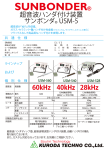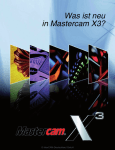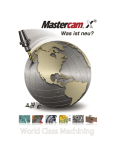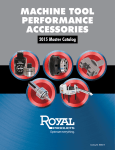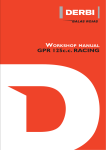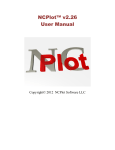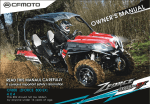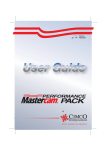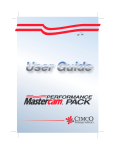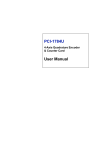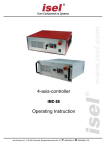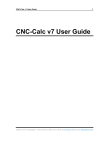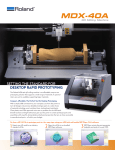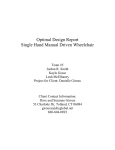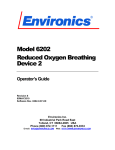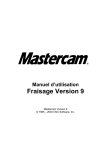Download Mastercam X2 Advanced Multiaxis Tutorial
Transcript
Advanced Multiaxis
Tutorial
Mastercam X2
Advanced Multiaxis
Tutorial
September 2006
ii • MASTERCAM X2 / ADVANCED MULTIAXIS TUTORIAL
Mastercam® Advanced Multiaxis Tutorial
Date: September 15, 2006
Copyright ©2006 CNC Software, Inc. — All rights reserved.
First Printing: September 15, 2006
Software: Mastercam X2
ISBN: 1-883310-61-X
IMPORTANT NOTICE!
PLEASE READ THIS STATEMENT AND THE SOFTWARE LICENSE AGREEMENT
COMPLETELY BEFORE USING THIS SOFTWARE.
BY CONTINUING TO USE THIS SOFTWARE, YOU (EITHER AN INDIVIDUAL OR A
SINGLE ENTITY) INDICATE YOUR INTENTION TO BE BOUND BY AND ACCEPT
THE TERMS AND CONDITIONS OF THIS SOFTWARE LICENSE. IF YOU DO NOT
AGREE TO THESE TERMS AND CONDITIONS, YOU MAY NOT ACCESS OR
OTHERWISE USE THIS SOFTWARE AND WILL IN FACT BE PROHIBITED FROM
DOING SO. THIS COMPUTER SOFTWARE MAY BE USED ONLY PURSUANT TO
THE TERMS AND CONDITIONS SET FORTH BELOW, AND SOLELY IN
CONJUNCTION WITH THE ACCOMPANYING SECURITY MECHANISM (UNLESS
OTHERWISE SPECIFIED IN THE "EXCEPTIONS TO SECURITY MECHANISM
REQUIREMENTS" SECTION OF SUCH TERMS AND CONDITIONS) WHICH MUST
BE PRESENT ON YOUR COMPUTER (OR NETWORK AS APPLICABLE) AT ALL
TIMES DURING SUCH USE.
Read This If You Have Received This Software From A Third Party: If you received
this Software from someone other than an authorized CNC Software, Inc. reseller,
you do NOT have a legal software license. (For example, if you acquired this
Software simply by buying a machine or Software from the former owner or from an
auction, you do not have a valid license.) You should contact CNC Software, Inc.
(860-875-5006) in order to obtain a new and valid license. Use of this Software
without a valid software license is unlawful, a violation of the Copyright Act and
may expose you to criminal liability under 17 United States Code Sec. 506,
including fines and damages.
Software License
If you have paid a license fee, CNC Software, Inc. ("CNC") a Connecticut
corporation with its principal place of business at 671 Old Post Road, Tolland,
Connecticut, 06084 hereby grants to you a non-exclusive, non-transferable license
(the "License") to use this software program (the "Software") and its accompanying
documentation (and, if applicable, to permit your authorized employees to use
them), solely in accordance with the terms and conditions of this Software License
Agreement . You may use the Software solely for your internal business purposes
and solely in conjunction with the accompanying hardware or software device,
method, scheme or other security measure provided by CNC which allows a user to
access the Software and prevents unauthorized access to the Software (the "Security
Mechanism"). The Software, any updates to the Software (including any that you
download through the Internet), and the Documentation shall hereinafter
collectively be referred to as the "Software" and are all governed by this License.
Restrictions
You may not use the Software without a Security Mechanism provided by CNC or
CNC’s suppliers. When CNC or CNC’s suppliers provide you with a single-user
Security Mechanism, the Software may only be used (in executable code form only)
on a single computer to which the Security Mechanism is physically attached. In the
event CNC or CNC’s suppliers provide you with a multiple-user Security
Mechanism for use over an internal network (a "Network Security Mechanism"), the
Software may be used: (a) in executable code form only; (b) only on end-user
computers that are connected to the internal network to which the Network
iii
Security Mechanism is attached; and (c) only by the number of users and accessed by the
number of end-user computers for which licenses were purchased and as further
allowed by the Network Security Mechanism. You may physically transfer the Software
from one computer equipped with a single-user Security Mechanism to another only if
the Security Mechanism is included in the transfer and is installed with the new
computer.
You shall not: (a) copy (except as provided below), adapt, modify the Software; (b)
publish, display, disclose or create a derivative work from the Software or any part
thereof; (c) de-compile or translate, disassemble, create or attempt to create, by reverse
engineering or otherwise, the source code form of the Software from the executable code
of the Software; (d) remove any proprietary notices, labels or marks from the Software;
(e) sell, rent, lease, distribute or otherwise transfer or provide all or any part of the
Software to any person or entity without the prior written consent of CNC; (f ) use the
Software to provide outsourcing, service bureau, time sharing or other services to any
third party; or (g) sublicense, assign, delegate or otherwise transfer your rights in the
Software, under the Software License Agreement or any of the related rights or
obligations for any reason without the prior written consent of CNC. You shall not
circumvent, bypass, modify, reverse engineer, disassemble, disable, alter, enhance or
replicate the function of the Security Mechanism in any manner whatsoever. Any
attempt to do so shall result in automatic termination of this License without prejudice
to all other legal rights and remedies of CNC.
Copying Restrictions
You may make one (1) copy of the Software for backup or archival purposes, provided
that you reproduce all proprietary notices of CNC on any such copy.
Non Transferable
You may not transfer or assign the Software or this Software License Agreement or any
rights or obligations hereunder. Any attempt to do so will automatically terminate this
License without the need for notice. This termination is without prejudice to all other
legal rights and remedies of CNC.
Intellectual Property
Rights
The Software is and includes intellectual property of CNC. All associated intellectual
property rights, including, without limitation, worldwide patent, trademark, copyright
and trade secret rights, are reserved. CNC retains all right, title and interest in and
copyrights to the Software, regardless of the form or media in or on which the original or
other copies may subsequently exist. This Software License Agreement shall not
constitute a sale of the Software and no title or proprietary rights to the Software are
transferred to you hereby. You acknowledge that the Software is a unique, confidential
and valuable asset of CNC, and CNC shall have the right to seek all equitable and legal
redress, which may be available to it for the breach or threatened breach of this Software
License Agreement including, without limitation, injunctive relief. Unauthorized
copying of the Software or failure to comply with the above restrictions shall result in
automatic termination of this License and this Software License Agreement without
prejudice to all other legal rights and remedies of CNC.
Confidentiality
Enforcement
Obligations
You acknowledge that the Software contains proprietary trade secrets of CNC and you
hereby agree to maintain the confidentiality of the Software using at least as great a
degree of care as you use to maintain the confidentiality of your own most confidential
information. You agree to reasonably communicate the terms and conditions of this
Software License Agreement to those persons employed by you who come into contact
with the Software, and to use reasonable best efforts to ensure their compliance with
such terms and conditions, including, without limitation, not knowingly permitting such
persons to use any portion of the Software for the purpose of deriving the source code of
the Software or defeating the Security Mechanism.
In the event you become aware that any person or entity in your employ or under your
control in a manner not authorized by this Software License Agreement is using the
Software, you shall immediately use reasonable best efforts to have such unauthorized
11
12
13
14
15
16
17
18
19
110
iv • MASTERCAM X2 / ADVANCED MULTIAXIS TUTORIAL
use of the Software immediately cease. You shall promptly notify CNC in writing of
any unauthorized use of the Software of which you become aware.
Limited Warranties
CNC WARRANTS THAT THE MEDIA ON WHICH THE SOFTWARE IS DISTRIBUTED
WILL BE FREE OF DEFECTS IN MATERIAL OR WORKMANSHIP FOR A PERIOD OF
THIRTY (30) DAYS AFTER PURCHASE. THE FOREGOING LIMITED WARRANTY
EXCLUDES DEFECTS ARISING OUT OF ACCIDENT, NEGLECT, MISUSE, FAILURE
OF ELECTRIC POWER AND CAUSES OTHER THAN ORDINARY AND AUTHORIZED
USE. EXCEPT FOR THE FOREGOING LIMITED WARRANTY, THE SOFTWARE IS
PROVIDED "AS IS, WITH ALL FAULTS." YOUR SOLE REMEDY AND CNC’S SOLE
OBLIGATION HEREUNDER SHALL BE, AT CNC’S SOLE OPTION, REPLACEMENT
OF THE DEFECTIVE MEDIA OR REFUND OF THE PURCHASE PRICE OF THE
SOFTWARE. ANY USE BY YOU OF THE SOFTWARE IS AT YOUR OWN RISK. THIS
LIMITED WARRANTY IS THE ONLY WARRANTY PROVIDED BY CNC REGARDING
THE SOFTWARE. TO THE MAXIMUM EXTENT PERMITTED BY LAW, CNC
DISCLAIMS ALL OTHER WARRANTIES OF ANY KIND, EITHER EXPRESSED OR
IMPLIED, INCLUDING, WITHOUT LIMITATION, IMPLIED WARRANTIES OF
MERCHANTABILITY AND FITNESS FOR A PARTICULAR PURPOSE. CNC IS NOT
OBLIGATED TO PROVIDE ANY UPDATES TO THE SOFTWARE. SHOULD THE
SOFTWARE PROVE DEFECTIVE FOLLOWING ITS PURCHASE, YOU (AND NOT
CNC, ITS DISTRIBUTOR, OR RETAILER) ASSUME THE ENTIRE COST OF ALL
NECESSARY SERVICING, REPAIR OR CORRECTION AND ANY INCIDENTAL OR
CONSEQUENTIAL DAMAGES.
Note on Documentation: While CNC makes every effort to ensure that its
Documentation for the Software is accurate and up-to-date, it cannot guarantee the
Documentation at all times represents the latest operation and functionality of the
Software. The content of the "Getting Started Guide," "User Manual" and other
documentation for the Software is provided for informational purposes only. The
content of the Documentation may be changed without notice to you. CNC
expressly disclaims any warranty or representation that the Documentation is an
accurate and/or current reflection of the Software’s operation and performance.
Limitation of Liability
IN NO EVENT WILL CNC, OR ITS EMPLOYEES, SHAREHOLDERS, DISTRIBUTORS
OR SUPPLIERS BE LIABLE TO YOU FOR ANY INDIRECT, INCIDENTAL, OR
CONSEQUENTIAL DAMAGES (INCLUDING WITHOUT LIMITATION, SPECIAL,
PUNITIVE OR EXEMPLARY DAMAGES FOR LOSS OF BUSINESS, LOSS OF
PROFITS, BUSINESS INTERRUPTION, OR LOSS OF BUSINESS INFORMATION)
ARISING OUT OF OR IN CONNECTION WITH THIS SOFTWARE LICENSE
AGREEMENT OR THE SUBJECT MATTER HEREOF EVEN IF CNC HAS BEEN
ADVISED OF THE POSSIBILITY OF SUCH DAMAGES. CNC’S ENTIRE LIABILITY
WITH RESPECT TO ITS OBLIGATIONS UNDER THIS SOFTWARE LICENSE
AGREEMENT OR OTHERWISE SHALL NOT EXCEED THE AMOUNT OF THE
LICENSE FEE PAID BY YOU FOR THE SOFTWARE. SOME JURISDICTIONS DO NOT
ALLOW THE EXCLUSION OR LIMITATION OF IMPLIED WARRANTIES OR
LIABILITY FOR INCIDENTAL OR CONSEQUENTIAL DAMAGES, SO THE ABOVE
LIMITATIONS OR EXCLUSIONS MAY NOT APPLY TO YOU.
Indemnification
You shall indemnify and hold harmless CNC, its officers, directors, employees,
suppliers and agents from and against all losses, settlements, claims, actions, suits,
proceedings, judgments, awards, damages, liabilities, costs and expenses including,
without limitation, reasonable attorneys’ fees (collectively "Losses") which arise out
of or as a result of any breach of this Software License Agreement by you or your
employees, agents, resellers, dealers or sub-dealers and shall reimburse CNC for
any and all legal, accounting and other fees, costs and expenses reasonably incurred
v
by any of them in connection with investigating, mitigating or defending any such
Losses.
Educational Pricing
If this Software was obtained through or in accordance with a CNC "Educational Pricing"
plan, option, grant, schedule or program, it may not be used by anyone, including you, to
conduct any computer aided design, computer aided drafting, computer aided
machining, or training activities that, directly or indirectly, generate or otherwise result
in monetary revenues for the benefit of any individual or any entity, other than the
school that originally received this Software.
Termination
This Software License Agreement is effective until terminated. You may terminate this
Software License Agreement at any time by returning to CNC all copies of the Software
under your control and by returning the Security Mechanism to CNC. CNC may
terminate this Software License Agreement if CNC determines, in its sole discretion, that
you have violated the terms of this Software License Agreement. Upon termination of
this Software License Agreement, you agree to immediately return to CNC all copies of
the Software, return the Security Mechanism to CNC, and certify to CNC in writing that
all known copies, including backup copies, have been returned. All provisions relating to
confidentiality, proprietary rights, indemnification and non-disclosure shall survive the
termination of this Software License Agreement. You may not transfer this Software to
the purchaser of any equipment on which the Software may be resident. You may not
transfer this Software via liquidation, bankruptcy, auction, close of business, or any
other method that does not involve an authorized Mastercam reseller. This License is
for you alone. In the event you breach the provisions of this Section, CNC shall be
entitled to liquidated damages in the amount of Fifteen Thousand Dollars ($15,000), plus
its reasonable attorney’s fees and court costs.
General
U.S. Government
Restricted Rights
Export Restrictions
This Software License Agreement shall be construed, interpreted and governed by the
laws of the state of Connecticut, without regard to conflicts of law provisions. The sole
jurisdiction and venue for any litigation arising from or related to this Software License
Agreement or the subject matter hereof shall be in an appropriate state or federal court
located in Hartford, Connecticut. You hereby submit to the personal jurisdiction of the
Federal District Court for the District of Connecticut and to the Superior Court of the
State of Connecticut. This Software License Agreement shall constitute the entire
agreement between you and CNC with respect to the subject matter hereof. Any waiver
or modification of this Software License Agreement shall be valid only if it is in writing
and signed by both parties hereto. If any part of this Agreement is found invalid or
unenforceable by a court of competent jurisdiction, the remainder of this Agreement
shall be interpreted so as to reasonably effect the intention of the parties.
The Software provided hereunder is a "commercial item," as that term is defined in 48
C.F.R. 2.101, consisting of "commercial computer software" and "commercial computer
software documentation," as such terms are used in 48 C.F.R. 12.212. Consistent with 48
C.F.R. 12.212 and 48 C.F.R. 227.7202-1 through 227.7202-4, the Software made available to
the United States of America, its agencies and/or instrumentalities, is provided with only
those rights set forth in this Agreement. Use, duplication or disclosure of the Software by
the government is subject to the restrictions as set forth in subparagraph (c)(1) and (2) of
the Commercial Computer Software-Restricted Rights clause at 48 C.F.R. 52.227-19, as
amended, or any successor regulations thereto.
You represent and warrant that you will not, without obtaining prior written
authorization from CNC and, if required, of the Bureau of Export Administration of the
United States Department of Commerce or other relevant agency of the United States
Government, export or re-export, directly or indirectly, the Software from the United
States to (i) any country destination to which export is restricted by the Export
Administration Regulations of the United States Department of Commerce; (ii) any
country subject to sanctions administered by the Office of Foreign Assets Control, United
States Department of the Treasury; or (iii) such other countries to which export is
11
12
13
14
15
16
17
18
19
110
vi • MASTERCAM X2 / ADVANCED MULTIAXIS TUTORIAL
restricted by any other United States government agency. You further agree that you
are solely responsible for compliance with any import laws and regulations of the
country of destination of a permitted export or re-export, and any other import
requirement related to a permitted export or re-export.
Exceptions to Security
Mechanism
Requirements
CNC software programs Mastercam Design LT and Mastercam Demo do not require
the use of Security Mechanisms, and the provisions in this Software License
Agreement relating to Security Mechanisms do not apply to your use of such
programs, provided, however, that such provisions shall apply to your use of all
other Software provided hereunder.
Survival
All provisions of this Software License Agreement relating to confidentiality, nondisclosure, CNC’s proprietary rights, disclaimers, and limits of liability, or
indemnification by Customer shall survive termination of this License for any
reason.
Reservation of Rights
All rights not expressly granted are reserved by CNC.
Trademarks
Mastercam is a registered trademark of CNC.
Windows, Windows 95, Windows 98, Windows NT, and Windows XP are registered
trademarks of Microsoft Corporation. Mastercam Verify is created in conjunction
with MachineWorks Ltd.
Printed in the United States of America.
Printed on recycled paper.
vii
Contents
1. Tutorials .................................................................................... 1
X
Introducing Advanced Multiaxis Toolpaths ....................... 2
Getting help .................................................................... 3
Before you begin ............................................................. 4
X
Tutorial 1: Parallel Cuts on a Cylinder ............................... 5
Exercise 1: Creating parallel cutting passes..................... 5
Exercise 2: Refining the cutting area .............................. 11
Exercise 3: Driving the tool with a leading curve .......... 13
Tilt angle and tool control.................................................... 16
Exercise 4: Controlling the tool axis ............................... 16
Gouge checking.................................................................... 20
Exercise 5: Gouge prevention by retracting the tool..... 21
Exercise 6: Omitting gouge points from the toolpath... 25
Approach and retract strategies........................................... 29
Exercise 7: Creating entry and exit moves ..................... 29
Exercise 8: Using a fixed tool angle ................................ 32
Exercise 9: Using a single point for tool axis control .... 34
Exercise 10: Stopping the toolpath on a gouge ............. 36
X
Tutorial 2: Multiaxis Toolpath Techniques ...................... 38
Exercise 1: Creating cuts parallel to a leading curve.....
Exercise 2: Creating a swarf toolpath .............................
Exercise 3: Handling problem areas in the part model
Exercise 4: Combining several gouge
and collision checks ........................................................
39
43
45
50
2. Application Examples ...................................................... 57
X
Example 1: Compressor Armature with 4-Axis Output . 58
Tooling ................................................................................. 59
Drive geometry and cutting passes...................................... 60
Tool axis control and gouge checking ................................. 61
viii
X
Example 2: Engraving ........................................................ 63
Tooling ................................................................................. 65
Drive geometry and cutting passes...................................... 66
Linking the cuts .................................................................... 68
Tool axis control and gouge checking.................................. 70
X
Example 3: Camshaft on a Multitasking Lathe ............... 71
Tooling ................................................................................. 73
Drive geometry and cutting passes...................................... 74
Tool axis control and gouge checking.................................. 77
X
Example 4: Electrode Machining ..................................... 79
Tooling ................................................................................. 80
Cutting parameters—semi-finish toolpath ......................... 82
Drive geometry and cutting passes .............................. 82
Tool axis control and gouge checking .......................... 83
Cutting parameters—finish toolpath................................... 85
Drive geometry and cutting passes .............................. 85
Tool axis control and gouge checking .......................... 87
X
Example 5: Impeller Floor Roughing ................................ 91
Drive geometry and cutting passes...................................... 93
Tool axis control................................................................... 96
Roughing options ................................................................. 97
Plunge roughing ........................................................... 98
X
Example 6: Impeller Blade Semi-finishing ..................... 101
Tooling ............................................................................... 102
Drive geometry and cutting passes.................................... 103
Tool axis control................................................................. 104
Gouge check strategies....................................................... 106
X
Example 7: Impeller Floor Finishing ............................... 107
Drive geometry and cutting passes.................................... 108
Tool axis control................................................................. 110
Gouge check strategies....................................................... 111
X
Example 8: Impeller Blade Finishing .............................. 113
Drive geometry and cutting passes.................................... 114
Tool axis control................................................................. 115
Gouge check strategies....................................................... 116
chapter 1
Tutorials
This chapter includes two tutorial examples designed to
introduce Mastercam’s new advanced multiaxis toolpaths. After
completing them, you should know enough about the basic
principles to begin applying them to specific applications.
Tutorial 1: Parallel Cuts on a Cylinder
Creating parallel cutting passes . . . . . . . . . . . . page 5
Refining the cutting area. . . . . . . . . . . . . . . . . . page 11
Driving the tool with a leading curve . . . . . . page 13
Controlling the tool axis . . . . . . . . . . . . . . . . . . page 16
Gouge prevention by retracting the tool . . . page 21
Omitting gouge points from the toolpath . . page 25
Creating entry and exit moves . . . . . . . . . . . . page 29
Using a fixed tool angle . . . . . . . . . . . . . . . . . . . page 32
Using a single point for tool axis control . . . page 34
Stopping the toolpath on a gouge . . . . . . . . . page 36
Tutorial 2: Multiaxis Toolpath Techniques
Creating cuts parallel to a leading curve . . . page 39
Creating a swarf toolpath . . . . . . . . . . . . . . . . . page 43
Handling problem areas in the part model . page 45
Combining several gouge
and collision checks . . . . . . . . . . . . . . . . . . . . . . page 50
These tutorials assume that you are generally familiar with
using Mastercam, including creating and backplotting
toolpaths, selecting geometry, working with surfaces, and using
the Toolpath Manager. If you have any questions about basic
Mastercam functions while working on these exercises, please
click the Help button on any dialog box or consult the
Mastercam X2 Reference Guide installed in the \Documentation
folder in your Mastercam installation directory.
2 • MASTERCAM X2/ Advanced Multiaxis Tutorial
Introducing Advanced Multiaxis
Toolpaths
Mastercam’s new advanced multiaxis toolpaths take advantage of a
comprehensive, multi-tabbed interface to collect all of your toolpath
functions in one place:
This tutorial focuses on the four most important tabs. You will use
these tabs for almost every toolpath that you create. Typically you will
complete them in order, working from left to right:
Surface paths—Use this tab to select drive geometry and cut
patterns and to organize the cutting passes.
TUTORIALS / Introducing Advanced Multiaxis Toolpaths • 3
Tool axis control—Use this tab to define the tool orientation
and machining limit angles. You can also configure the
contact point and choose 3-axis, 4-axis, or 5-axis output.
Gouge check—Use this tab to configure up to four
independent gouge- and collision-checking routines. Each
individual gouge-check routine can have its own set of check
surfaces and geometry and its own type of retract or collision
avoidance movement.
Link—Use this tab to configure tool motions for entry and exit
moves, moves between passes, and moves that span gaps in
your surfaces or toolpaths. You can also specify clearance
distances and safety zones.
The advanced multiaxis toolpaths also include a Toolpath parameters
tab for selecting and managing tools and setting feeds and speeds.
This is the same tab used in other Mastercam toolpaths, and so is not
described in this tutorial.
Getting help
The advanced multiaxis interface includes many detailed pictures that
are linked to individual fields. Simply click in a field to display a visual
explanation of it:
Every dialog box includes a main help button in the lower right corner
that you can click to learn more.
1
4 • MASTERCAM X2/ Advanced Multiaxis Tutorial
Before you begin
Although these toolpaths are extremely powerful and flexible, there are
some important limitations that you should be aware of.
These toolpaths work on surfaces, solids, and solid faces. Solid
selection is available for most advanced multiaxis toolpath
strategies, with the following exceptions:
Toolpaths that require the selection of a defined edge
(solid edge)
Toolpaths that require the selection of only a single surface
(solid face)
The orientation of the toolpath with respect to your surfaces is
determined by the surface normal. Before creating the
toolpath, make sure that your normals point in the proper
direction. If necessary, use the Edit, Change normals function
before creating the toolpath. (You can also change the
normals after creating the toolpath and simply regenerate the
toolpath.)
The defaults for these toolpaths are hard-coded and are not
stored in the .defaults file with your other toolpath defaults.
TUTORIALS / Parallel Cuts on a Cylinder • 5
Tutorial 1: Parallel Cuts on a Cylinder
The first tutorial is a simple toolpath that creates parallel cuts around a
cylinder, as shown in the following picture. It measures 80mm long,
with a radius of 40mm, with its long axis parallel to the X axis. You will
use a 30mm ball endmill.
The part geometry and tool are saved in the following file:
\Documentation\ExampleParts\Multiaxis_Example1.mcx
Load this part to begin the tutorial.
Note: All the parts and tools in this tutorial are metric.
Exercise 1: Creating parallel cutting passes
X Starting the advanced multiaxis toolpaths
1 From the Toolpaths menu, choose Advanced Multiaxis.
1
6 • MASTERCAM X2/ Advanced Multiaxis Tutorial
The Select User Interface dialog box displays. It gives you the
option of selecting one of several application-specific
interfaces. These are simplified interfaces that let you quickly
create toolpaths for specific needs; most of the options are set
automatically “behind the scenes” and are hidden from you.
For this tutorial, you will use 5-Axis Multi Surface. This is the
main interface that exposes all of the multiaxis options, so it
provides a better introduction to the advanced multiaxis
capabilities.
2 Select 5-Axis Multi Surface and click OK.
3 On the Toolpath Parameters tab, choose the 30mm ball
endmill.
TUTORIALS / Parallel Cuts on a Cylinder • 7
X Selecting a cutting pattern
1 Select the Surface paths tab.
2 Select Parallel cuts as the cutting pattern.
3 Set the Machining angle in X,Y to 0, and the Machining angle
in Z to 90.
1
8 • MASTERCAM X2/ Advanced Multiaxis Tutorial
The other options that are available in the Pattern section
depend on the selected cut pattern. For parallel cuts, the most
important parameters are the angle and orientation of the
cuts.
Use Machining angle in Z to orient the tool plane in which
the cuts are created. A value of 0 creates cuts parallel to the
XY plane, while 90 creates cuts perpendicular to it.
Use Machining angle in X,Y to rotate the orientation of the
cuts within the cutting plane. A value of 0 creates cuts
aligned with the Y axis, while 90 creates cuts aligned with
the X axis.
You can type values directly in the fields or use the other
buttons to pre-set values for typical applications:
Click Constant Z to create waterline-style passes along the
surfaces.
Click Parallel to orient the cutting passes perpendicular to
the XY plane.
Click the […] button to select other planar orientations.
Mastercam automatically fills in the machining angles to
match the selected plane.
For this application, all you need to do is click Parallel to set
the proper machining angles.
X Selecting the drive surfaces
1 Click the Drive surfaces button.
TUTORIALS / Parallel Cuts on a Cylinder • 9
2 Select the red surface shown below.
3 Enter 0 for Drive surfaces offset.
To leave stock on the drive surface, enter a positive value
here.
To cut below the drive surface, enter a negative value.
X Organizing the cutting passes
1 From the Cutting method list, select One way.
1
10 • MASTERCAM X2/ Advanced Multiaxis Tutorial
This makes the tool run around the cylinder in one direction.
Using Zigzag would alternate the cutting direction with every
cut.
2 Set the Maximum stepover to 10. That sets the distance
between every slice to 10mm.
3 Click OK to generate the tool path.
TUTORIALS / Parallel Cuts on a Cylinder • 11
Your cutting passes should look like the following picture:
Note: For clarity’s sake, most of the toolpath pictures in this
tutorial are taken while backplotting.
Exercise 2: Refining the cutting area
In the toolpath above, notice that there are gaps between the edge of
the model and the first and last cutting passes. The gap is
approximately half the maximum stepover amount. In this exercise,
you will modify the toolpath to eliminate them. You will also start the
toolpath at the top of the cylinder instead of the side.
X Expanding the cutting area
1 If necessary, click the Parameters icon in the Toolpath
Manager to display the settings for the existing operation.
1
12 • MASTERCAM X2/ Advanced Multiaxis Tutorial
2 On the Surface paths page, change the Area Type to Full start
and end at exact surface edge.
Use these options to either explicitly include the edge of the
surfaces, or exclude them. For example, if there are problems
on the edges of your surfaces, calculating a cutting pass
slightly away from the exact edge might reduce chatter and
produce a cleaner toolpath.
3 Click the Start point check box and button.
4 Enter a start point of X0, Y0, Z40.
TUTORIALS / Parallel Cuts on a Cylinder • 13
Note: Mastercam uses this point as a hint or guideline only. It tries
to start the toolpath close to this point, subject to the other drive
surface and cut pattern settings.
5 Click OK and then regenerate the toolpath. It should look like
the following picture.
Exercise 3: Driving the tool with a leading curve
In this exercise, the cutting pattern will be based on a leading curve.
Mastercam creates cuts normal to the leading curve and projects them
onto the drive surfaces. In this case, the curve will be a line through the
middle of the cylinder. For this part, this produces results similar to the
previous exercise, but without needing to set machining angles. This
technique is often used when the cylinder is a more complex shape,
such as a head port.
Note: The line that you will use as a drive curve is on level 3 in your
part file. If necessary, make this level visible to display the line.
1
14 • MASTERCAM X2/ Advanced Multiaxis Tutorial
X Selecting the leading curve
1 Make a copy of the toolpath from the previous exercises. (You
will edit it again in later exercises.)
2 Click the Parameters icon in the Toolpath Manager for the
new operation.
3 On the Surface paths page, change the Pattern to Cuts along
curve.
4 Click the Lead button.
5 Select the line as shown in the following picture. The chaining
direction of the selected curve determines where the toolpath
will begin.
TUTORIALS / Parallel Cuts on a Cylinder • 15
X Limiting the cutting area between two points
For this toolpath, you will limit the cutting area to the area between
two points. This lets you limit the cutting zone to a specific portion
of the cylinder.
1 From the Area: Type list, select Limit cuts by one or two
points.
2 Click the Advanced button and enter the limits X–25 and X–
65. Mastercam will create the toolpath between these two
points only.
TIP: If the two points are the same, Mastercam will create a
single pass through the point.
3 Click OK to close all the dialog boxes and then regenerate the
tool path.
1
16 • MASTERCAM X2/ Advanced Multiaxis Tutorial
Your cutting passes should look like the following picture:
Tilt angle and tool control
The Tool axis control tab lets you define the tool axis relative to the
drive geometry, cutting direction, guide or construction geometry, or a
combination of them. You can also specify:
lead/lag angles, side tilt angles, and angle limits
tool tip and contact point, including user-defined locations
on the tool tip
output type (3-axis, 4-axis, or 5-axis)
Exercise 4: Controlling the tool axis
For this exercise, you will modify the toolpath that you created in
Exercises 1 and 2.
X Applying lead/lag angles
1 Click the Parameters icon in the Toolpath Manager for
Operation 1.
TUTORIALS / Parallel Cuts on a Cylinder • 17
2 Select the Tool axis control tab.
3 Select the Be tilted relative to cutting direction strategy.
4 Enter a Lead angle of 15 degrees.
5 Click OK to close all the dialog boxes and then regenerate the
tool path.
The original setting of the tool axis was fixed and normal to the
surfaces. With the new tool axis strategy, you can define a lead/lag
angle to cutting direction.
Positive value = lead angle (tool leans to the movement
direction)
Negative values = lag angle (tool leans away from the
movement direction).
1
18 • MASTERCAM X2/ Advanced Multiaxis Tutorial
When you backplot the toolpath from the right side, the lead angle
should appear as follows:
X Applying side tilt angles
1 Click the Parameters icon and select the Tool axis control tab.
2 Select the Tilted with fixed angle to axis strategy.
TUTORIALS / Parallel Cuts on a Cylinder • 19
3 Enter a Fixed tilt angle of 45 degrees, relative to the X axis, as
shown in the following picture.
4 Click OK to close all the dialog boxes and then regenerate the
tool path.
Use this option to set the tool axis at a fixed angle to any axis
or to a line that you choose. The tilt axis and surface normal
build a plane in which the tool tilts. Notice that Mastercam
still calculates the location of the cutting pass based on the
1
20 • MASTERCAM X2/ Advanced Multiaxis Tutorial
tool tip, but offset from the surface to maintain the proper
contact point
The tool will stay tilted towards X+ in a constant angle of 45
degrees all along the tool path.
Gouge checking
The Gouge check tab lets you define up to four independent gouge
and collision checks to be applied to your toolpath. Each one has three
main components:
the parts of the tool to check—tool tip, shaft, arbor, holder, or
any combination.
the type of action to take when a collision is detected—retract
away from the toolpath, tilt the tool away, omit the points
completely, or stop processing the toolpath. For each option,
additional parameters let you configure the tool motion.
the geometry to check against. You can select drive surfaces,
check surfaces, or both. For maximum flexibility, each
individual test has its own set of geometry, and this can be
completely independent of the surfaces selected in the
Surface paths tab.
TUTORIALS / Parallel Cuts on a Cylinder • 21
To prepare for this exercise, make level 2 visible. This contains the
check surfaces that you will collision-check against. Your part should
look like the following picture:
Exercise 5: Gouge prevention by retracting the tool
X Selecting and applying a gouge-check strategy
1 Click the Parameters icon for Operation 1.
2 Turn off the tool axis options from the last exercise. Select the
Tool axis control tab and select the Not be tilted and stays
normal to surface strategy.
3 Select the Gouge check tab.
1
22 • MASTERCAM X2/ Advanced Multiaxis Tutorial
4 Activate gouge check number 1 by selecting it in the Status
column.
5 Select the Tool tip, Tool shaft, and Arbor to check against.
TIP: You can define individual clearance values for each tool
component by clicking the Clearances for tool parts button.
6 Select the Retracting tool along tool axis strategy. This will
retract the tool along its axis until the gouge condition is no
longer present.
7 Since the purpose of this test is to check against the red box,
de-select the Drive surfaces option and select Check
surfaces. Click the […] button and select all the red surfaces.
8 If necessary, deselect the Check gouge between positions
option.
TUTORIALS / Parallel Cuts on a Cylinder • 23
9 Click OK and then regenerate the toolpath. It should look like
the following picture.
1
24 • MASTERCAM X2/ Advanced Multiaxis Tutorial
Even while the tool is passing around the check surfaces, the tool axis
is still normal to the drive surface, as set in the Tool axis control tab.
X Gouge checking between positions
1 Make a copy of the operation.
2 Go to the Gouge check tab for the new copy and select the
Check gouge between positions option.
3 Click OK and then regenerate the toolpath.
TUTORIALS / Parallel Cuts on a Cylinder • 25
When you backplot the toolpath and compare it to the previous
operation, you should see a subtle difference as the tool rounds the
sharp corner of the check surface.
Selecting this option causes Mastercam to insert additional nodes in
the toolpath that result in more accurate gouge checking around sharp
corners and other sharp or discontinuous areas of your model.
Selecting this option results in increased toolpath processing time, but
can produce more accurate gouge checking.
Exercise 6: Omitting gouge points from the toolpath
In the previous exercise, the tool is effectively machining the check
surface, since there is 0 stock to leave on those surfaces. In this
exercise, you will apply a different retract strategy to the check
surfaces. The goal will be to prevent the machining over the check
surfaces and maintain a minimum 2mm distance from them.
X Applying the “Leaving out gouging points” strategy
1 Open the toolpath parameters for the current operation.
2 Go to the Gouge check tab and change the gouge strategy to
Leaving out gouging points.
1
26 • MASTERCAM X2/ Advanced Multiaxis Tutorial
3 Set the Stock to leave for the check surfaces as 2. Your
options should look like the following picture.
4 Click OK and then regenerate the toolpath.
You can see that now when the tool reaches a check surface, it retracts
to a clearance plane. When it approaches the part, it still maintains a
minimum 2mm from the check surface. In the next procedure you will
define a better clearance zone.
TUTORIALS / Parallel Cuts on a Cylinder • 27
X Defining clearance planes and safety zones
1 Open the toolpath parameters for the operation and select the
Link tab. Use the Link tab to configure non-cutting tool
movements between cutting passes, as well as entry and
retract moves.
2 Click the Clearance area button.
3 From the Type list, select Cylinder parallel to X and enter a
radius of 65. Enter anchor point coordinates of X=0, Y=0,
and Z=0. This establishes a clearance plane which wraps
around the part 65mm from the centerline.
4 Click OK to close this dialog box, but leave the Link tab on the
screen.
X Defining the motion to and from the clearance plane
1 Click the Distances button.
2 Enter 5 for the Rapid distance. This establishes an
intermediate point to which the tool will rapid from the
clearance plane.
1
28 • MASTERCAM X2/ Advanced Multiaxis Tutorial
3 Enter 3 for the Feed distance. Once the tool reaches this
distance from the surface, it will feed towards the part.
Both distances are measured along the tool axis from the
surface being machined.
4 Enter 10 as the Air move safety distance. As the tool moves
across the clearance area, Mastercam ensures that the tool
will not come closer to the check surfaces than this distance.
5 Click OK and then regenerate the toolpath. You can see that
the tool movements around the check surfaces are much
more efficient and appropriate for this part.
Notice that the radius of the clearance cylinder is larger than the
programmed radius of 65mm. Mastercam automatically increases the
TUTORIALS / Parallel Cuts on a Cylinder • 29
size so that the tool moves safely around the check surfaces, while
maintaining the air move safety clearance.
Approach and retract strategies
This section introduces you to different combinations of tool axis
control, gouge check, and link settings that you can use to bring the
tool on and off the part and retract from check surfaces.
Exercise 7: Creating entry and exit moves
X Adjusting the start point
1 Open the toolpath parameters for the operation and select the
Surface paths tab.
2 Click the Start point button.
1
30 • MASTERCAM X2/ Advanced Multiaxis Tutorial
3 Change the start point coordinates to X0, Y–40, and Z0, so
that the tool will start machining at the side of the part instead
of the top.
4 Enter a Rotate by (Deg) angle of 8 and click OK. This rotates
the starting point of each successive cutting pass by 8 degrees.
X Creating an entry move
1 Go to the Link tab.
2 In the First entry area, set the entry options to From
clearance area and Use entry macro.
3 In the Last exit area, set the entry options to Back to
clearance area and Use exit macro.
In this case, the word “macro” simply means that you will
configure a series of tool motions to approach and retract
TUTORIALS / Parallel Cuts on a Cylinder • 31
from the part, instead of the simple straight linear moves that
you have been using so far.
4 Click the Entry/Exit macro button to begin defining the
moves.
5 Select Vertical tang. arc for both the entry and exit macro.
This will create an arc move aligned with the parallel cutting
passes.
6 Set the Arc diameter to 100% for both arcs.
7 Click OK and then regenerate the toolpath.
Your toolpath should look like the following picture. The tangential
arcs are applied to the first and last cutting passes only. In this case, the
Rapid distance and Feed distance set in the previous exercise are
added to the beginning and end of the arc. You can see that between
1
32 • MASTERCAM X2/ Advanced Multiaxis Tutorial
each pass, the tool retracts to the clearance plane while Mastercam
shifts the start of the next cutting pass by 8 degrees.
Exercise 8: Using a fixed tool angle
X Locking the tool axis to a fixed angle
1 Open the toolpath parameters for the operation and select the
Tool axis control tab.
2 Select the Tilted with fixed angle to axis strategy.
TUTORIALS / Parallel Cuts on a Cylinder • 33
3 Select X-axis and set the Fixed tilt angle to 45.
X Locking the retract moves to fixed plane
1 Go to the Gouge check tab.
2 Change the strategy to Moving tool away and Retract tool in
YZ plane. This will lock the retract moves to a constant X
value.
3 Click OK and then regenerate the toolpath.
You can see that even though the retract moves are locked to a
constant Z, Mastercam maintains the 45-degree tilt in the tool axis.
With this retract strategy, the tool does not pull all the way out to the
1
34 • MASTERCAM X2/ Advanced Multiaxis Tutorial
clearance plane, but just enough to maintain the Stock to leave
amount.
Exercise 9: Using a single point for tool axis control
X Tilting the tool axis to a point
1 Open the toolpath parameters for the operation and select the
Tool axis control tab.
2 Select the Tilted from point away strategy.
3 Click the […] button to select the point, and click it again to
return to the graphics window.
TUTORIALS / Parallel Cuts on a Cylinder • 35
4 Select the midpoint of the purple line that runs along the
cylinder axis.
5 Mastercam fills in X–40 in the Point dialog box. Click OK to
close it.
6 Set the Tilt angle to 0 and select the X-axis. Even though you
have chosen to base the tool axis on the tilt angle from the
point, Mastercam lets you enter an additional angle to add to
it.
1
36 • MASTERCAM X2/ Advanced Multiaxis Tutorial
7 Click OK and then regenerate the toolpath. Notice that at all
times the tool axis is pointing away from the point.
TIP: Mastercam also includes a Tilt through point option that
you can use when the point is outside the part.
Exercise 10: Stopping the toolpath on a gouge
X Selecting the gouge-check strategy
1 Open the toolpath parameters for the operation and select the
Gouge check tab.
TUTORIALS / Parallel Cuts on a Cylinder • 37
2 Select the Stop tool path calculation strategy.
3 Click OK and then regenerate the toolpath. Mastercam
generates a partial toolpath and stops toolpath calculations
when it detects a gouge.
1
38 • MASTERCAM X2/ Advanced Multiaxis Tutorial
Tutorial 2: Multiaxis Toolpath Techniques
The second tutorial introduces a number of more sophisticated
multiaxis techniques to machine the interior of this part. You will use a
10mm flat endmill.
Some of the skills you will learn include:
creating a swarf toolpath
handling problem areas in your part model
creating multiple collision checks for part fixtures and other
check surfaces
The part geometry and tool are saved in the following file:
\Documentation\ExampleParts\Multiaxis_Example2.mcx
Load this part to begin the tutorial.
Note: All the parts and tools in this tutorial are metric.
TUTORIALS / Multiaxis Toolpath Techniques • 39
Exercise 1: Creating cuts parallel to a leading curve
X Selecting the geometry
1 From the Toolpaths menu, choose Advanced Multiaxis.
2 Select 5-Axis Multi Surface and click OK.
3 On the Toolpath parameters tab, select the 10mm flat
endmill.
4 Select the Surface paths tab.
5 Select Parallel to curve as the cutting pattern.
This option aligns the cut direction parallel to a leading curve.
Mastercam’s advanced multiaxis toolpaths can handle convex
surfaces, which are very common in injection molds and
forging dies.
1
40 • MASTERCAM X2/ Advanced Multiaxis Tutorial
6 Click Single edge and select the red curve.
7 Click Drive surfaces and select both highlighted surfaces.
8 Click Done.
TUTORIALS / Multiaxis Toolpath Techniques • 41
X Configuring the cutting passes
1 In the Area section, set the type to Full, avoid cuts at exact
edges.
With this setting, the toolpath will be generated on the whole
surface, but a cutting pass will not be calculated on the exact
edge of the surface. This is useful in case the boundary of the
drive surfaces is not smooth. The maximum distance from the
edge will be less the half the maximum stepover.
2 Select the Zigzag cutting method.
3 Set the Cut tolerance to 0.01 and Maximum stepover to 2.
1
42 • MASTERCAM X2/ Advanced Multiaxis Tutorial
4 Click OK to generate the toolpath. It should look like the
following picture.
TUTORIALS / Multiaxis Toolpath Techniques • 43
Exercise 2: Creating a swarf toolpath
The toolpath in the previous exercise was machined with the tool in an
almost horizontal position:
In this exercise, you will modify this toolpath to produce a true swarf
toolpath, with a single cut along the bottom rail. This exercise is also a
good illustration of how tool axis control and gouge-check settings
work together to meet sophisticated tool control needs.
X Editing the cutting pattern
1 In the Toolpath Manager, make a copy of the previous
operation and click its Parameters icon to edit it.
2 Go to the Surface paths page.
3 Change the area type to Determined by number of cuts and
set the number of cuts equal to 1.
1
44 • MASTERCAM X2/ Advanced Multiaxis Tutorial
Since this will be a swarf toolpath, you only need a single pass
along the curve.
4 Set the Cutting method to One way.
X Setting the tool axis control
1 Go to the Tool axis control tab.
2 Choose the Tool axis will be tilted relative to cutting
direction strategy.
3 Set the Tilt angle at side of cutting direction to 90.
The 90 degree side tilt changes the tool from its almost
horizontal orientation, normal to the surfaces, to a vertical
orientation suitable for swarfing.
X Creating the gouge-check strategy
1 Go to the Gouge check tab and activate strategy 1.
2 Select the Tool tip, Tool shaft, and Arbor to check against.
3 Select the Tilting tool away with max angle strategy, and
select Use side tilt angle option. This will tilt the tool away
from the drive surfaces just enough to avoid gouging.
TUTORIALS / Multiaxis Toolpath Techniques • 45
4 Clear the Check surfaces option, since you are only working
with drive surfaces in this part. Your settings should look like
this:
5 Click OK and then regenerate the toolpath. You should see a
single cut with the tool axis aligned with the drive surfaces.
Exercise 3: Handling problem areas in the part model
If you look closely at the toolpath from the previous exercise, you can
see several problem areas.
1
46 • MASTERCAM X2/ Advanced Multiaxis Tutorial
First, there is a sharp corner where the two surfaces meet. This results
in a “fishtail” in the toolpath:
TUTORIALS / Multiaxis Toolpath Techniques • 47
Second, there is a gap in the drive surface that causes the tool to
retract, even though the lead curve is continuous:
In this exercise you will learn how to handle both these problems.
X Eliminating fishtails in your toolpath
1 Open the toolpath parameters for the operation and select the
Surface paths tab.
2 Select the Round corners option.
This option works like a fillet generator for your toolpath. The
surface model is rounded (filleted) in the direction of the
toolpath slices with a radius sufficiently large to smooth sharp
corners and corners with very small radii.
The radius used by Mastercam is the radius of the tool plus the
current stock to leave value. This option is used most often
with ball cutters, lollipop cutters, or conical cutters with a ball
tip. Using this option with end mills is also appropriate for
swarf machining, like this part.
1
48 • MASTERCAM X2/ Advanced Multiaxis Tutorial
TIP: Click the Round corners button to increase the implied
radius by a fixed amount.
3 Click OK and then regenerate the toolpath. When you zoom in
on the area, you should see a clean transition between
surfaces.
X Handling surface gaps in your toolpath
The Link tab includes a section that lets you specify how to handle
large and small gaps. You can define which gaps are small and large as
a percentage of the tool size.
In this case, the gap is approximately 25mm, so you will set the
separation between small and large gaps at 300% of the tool diameter,
thereby defining this as a small gap.
1 Open the toolpath parameters for the operation and select the
Link tab.
TUTORIALS / Multiaxis Toolpath Techniques • 49
2 Select Blend spline as the Small gaps strategy.
The goal is to keep the toolpath close to the geometry and not
have it retract at all. The blend spline strategy connects the
drive surfaces with a toolpath move that leaves and enters the
existing surfaces tangentially.
3 Enter 300 to define the Small gap size.
1
50 • MASTERCAM X2/ Advanced Multiaxis Tutorial
4 Click OK and then regenerate the toolpath. When you zoom in
on the area, you should see a smooth toolpath in the gap area.
Exercise 4: Combining several gouge and collision
checks
In the previous exercises, you used the gouge-checking function to
help define the proper tool position for a swarf toolpath. In this
exercise, you will apply additional gouge checks to keep the tool away
from check surfaces.
TUTORIALS / Multiaxis Toolpath Techniques • 51
Before beginning this exercise, use the Level Manager to make level
100 visible. Your part should now display a horizontal bar:
X Collision-checking the bar
1 In the Toolpath Manager, make a copy of the previous
operation and click its Parameters icon to edit it.
2 Go to the Gouge check tab.
3 Select gouge check 2 in the Status column.
4 Select the Tool tip, Tool shaft, Arbor and Holder to check
against.
5 Set strategy to Retracting tool along tool axis.
6 De-select Drive surfaces and select Check surfaces. There is
no need to check the drive surfaces with this test, since they
are handled in the first test. For this test, Mastercam will only
look at the check surfaces.
7 Enter 0.5 as Stock to leave, and 0.05 as the Tolerance.
1
52 • MASTERCAM X2/ Advanced Multiaxis Tutorial
The goal of this setting is to prevent machining the check
surfaces, while staying within 0.5 mm of them.
Your settings should look like this:
8 Click the […] button and select all the red surfaces.
9 Click OK and then regenerate the toolpath. The toolpath
should clear the bar with a 0.5mm clearance like in the
following picture.
TUTORIALS / Multiaxis Toolpath Techniques • 53
X Collision-checking external fixtures
You will now modify the collision checks to verify that the tool and
holder do not collide with an external fixture. Before continuing,
make level 101 visible in your part file to expose these surfaces.
You will also change the cut pattern, to create additional cutting
passes near the top of the surfaces to check against the fixture.
1 Open the toolpath parameters for the operation and select the
Surface paths tab.
2 Change the Area type to Full, avoid cuts at exact edges.
3 Change the Cutting method to Zigzag.
1
54 • MASTERCAM X2/ Advanced Multiaxis Tutorial
4 Change the Maximum stepover to 10.
5 Go to the Gouge check tab
6 Edit gouge check 1:
Add the Holder to check against. (See the picture below.)
Select Check surfaces and select the surfaces for the red
fixture.
7 Edit gouge check 2:
Select the Moving tool away strategy.
Set the retract option to Retract tool in +Z.
Your settings should look like the following picture:
TUTORIALS / Multiaxis Toolpath Techniques • 55
8 Click OK and then regenerate the toolpath. You can see the
tool axis tilt when the holder approaches the fixture.
Also, look at the new retract strategy around the bar. The tool
retracts straight up in Z instead of along the tool axis, which is
1
56 • MASTERCAM X2/ Advanced Multiaxis Tutorial
a much more appropriate strategy with the multiple cutting
passes.
Congratulations! You have completed the tutorial portion of this book.
Continue with the next chapter to learn about specific application
examples and how they are created.
chapter 2
Application Examples
This chapter introduces several application examples. Instead
of giving you step-by-step procedures like the tutorials in the
previous chapter, this chapter discusses how to apply the
advanced multiaxis toolpaths to specific types of parts and
explains the key settings that make each toolpath appropriate
for its application.
It includes the following examples:
Example 1:Compressor Armature with 4-Axis Output
page 58
Example 2:Engraving . . . . . . . . . . . . . . . . . . . . . . page 63
Example 3:Camshaft on a Multitasking Lathe page 71
Example 4:Electrode Machining . . . . . . . . . . . . . page 79
Example 5:Impeller Floor Roughing . . . . . . . . . page 91
Example 6:Impeller Blade Semi-finishing. . . .page 101
Example 7:Impeller Floor Finishing . . . . . . . . .page 107
Example 8:Impeller Blade Finishing . . . . . . . .page 113
Completed parts for each exercise can be found in the
\Documentation\ExampleParts folder in your Mastercam
installation folder. (The four impeller examples all use the
same part.) Remember that for almost any multiaxis
application, there are many possible machining strategies. Feel
free to use these examples as starting points, trying out
different settings and techniques that are relevant to your own
work and your own preferences.
58 • MASTERCAM X2/ Advanced Multiaxis Tutorial
Example 1: Compressor Armature with
4-Axis Output
In this example, you will machine the outside of this compressor
armature. The part lies along the X axis.
The approach will be to machine with the side of the tool, using a 4axis toolpath that rotates around the part in a continuous spiral. You
can typically get much better surface finishes, longer tool life and
shorter cycle times when cutting with the side instead of the bottom of
the cutter, so you will use the advanced multiaxis toolpaths to take
advantage of this.
To begin, open the following file:
\Documentation\ExampleParts\Compressor_armature.mcx
APPLICATION EXAMPLES / Compressor Armature with 4-Axis Output • 59
The following picture shows the desired cutting motion:
2
Tooling
For this part, use a 0.375-inch flat endmill.
60 • MASTERCAM X2/ Advanced Multiaxis Tutorial
Drive geometry and cutting passes
Use the following Surface paths settings:
Use the Parallel cuts pattern to create the cutting passes.
Each cut needs to be parallel to a vertical plane, so set the
Machining angle in Z to 90. Since the part is parallel to the X
axis, the Machining angle in X,Y should be left at 0.
For Drive surfaces, select the single armature surface.
Select the One way cutting method to keep rotating the part
in the same direction for all the passes.
APPLICATION EXAMPLES / Compressor Armature with 4-Axis Output • 61
In addition, select the following option on the Utility tab:
2
This converts all of the separate parallel cuts into a single continuous
spiral, which is ideal for this part.
Tool axis control and gouge checking
Use the following Tool axis control settings:
To generate the 4-axis output, simply select it as the Output
format and click the Rotary Axis button to select the desired
axis.
The other settings lock the tool at a 90-degree angle to the X
axis. As the part rotates, the side of the tool will machine it.
62 • MASTERCAM X2/ Advanced Multiaxis Tutorial
There is no need for gouge checking for this toolpath, so all the options
on the Gouge check tab are turned off.
In the next example, you will learn about settingup an engraving
application.
APPLICATION EXAMPLES / Engraving • 63
Example 2: Engraving
5-axis engraving is popular in the mold and die industry. There are
company logos, recycling icons, volume markers, and artistic designs
engraved on molding surfaces deep inside cavities or on free-form
surfaces on cores. In this example, you will engrave the words
Mastercam X2 on the side of the part as shown below:
You must use a small cutter, and you can only get superior results if
you stay normal to the surfaces you are cutting—5-axis motion is a
requirement. In this example, you will use a slender V-groove cutter
with a 3-degree taper. The 5-axis engraving toolpath maintains the
depth of the cut contour relative to the drive surface. This is especially
noticeable when using V-groove cutters, since the width of the
engraved contour will remain constant.
To begin, open the following file:
\Documentation\ExampleParts\Engraving.mcx
2
64 • MASTERCAM X2/ Advanced Multiaxis Tutorial
The following picture shows the desired toolpath:
APPLICATION EXAMPLES / Engraving • 65
Tooling
For this part, use a tapered endmill with the following dimensions.
Note that this is a metric part so these dimensions are in mm.
2
66 • MASTERCAM X2/ Advanced Multiaxis Tutorial
Drive geometry and cutting passes
Use the following Surface paths settings:
Use the Project curves pattern to create the cutting passes.
Click the Projection button and select the geometry to be
engraved. (In the sample file, the letters are organized by
themselves on level 20 to make selection easier. You could also
select them easily using a color mask.)
IMPORTANT: The curves must already lie on the surfaces
before machining.
APPLICATION EXAMPLES / Engraving • 67
For drive surfaces, select just the surfaces shown:
2
To control the engraving depth, use the Axial shift parameter
on the Utility tab. This setting shifts the toolpath along the
tool axis by a specified amount. Use a negative amount to cut
below the surface. In this case, the value of –0.1mm means
that the tool will cut just below the surface.
68 • MASTERCAM X2/ Advanced Multiaxis Tutorial
Linking the cuts
Use the following settings on the Link tab:
The two settings that are marked in the picture are the key ones.
Use the Gaps along cut settings to control what happens if
there are small gaps or discontinuities in the geometry within
each letter. In this case, select the Blend spline strategy to
have the tool continue to feed along a smooth, tangential
connecting spline between any gaps. Set a threshold of 100%
of the tool diameter to define when a gap is considered small.
For gaps larger than this, the tool will retract from the
toolpath.
Use the Links between slices section to control how the tool
moves between letters. In this case, Broken feed means that
the tool will continue at the feed rate, but will retract to a feed
plane to move to the next letter. The size threshold is,
intentionally, very small—10% of the tool diameter. This is
because you don’t know the exact spacing between letters, so
the amount is set very low to capture all of the possible
APPLICATION EXAMPLES / Engraving • 69
transitions. (The dialog box says % of stepover, but since
there is no stepover for a Project toolpath, Mastercam uses the
tool diameter instead.)
The retract distance is set by clicking the Distances button.
2
In this case, the Feed distance is set at 2mm, so the tool will retract
2mm from the surface between each letter.
70 • MASTERCAM X2/ Advanced Multiaxis Tutorial
Tool axis control and gouge checking
Use the following Tool axis control settings:
For this application, it is important that the tool stay normal to the
surface and not otherwise tilt. The 5-axis output is required to
maintain this orientation.
Gouge checking is turned off for this toolpath because it is not needed.
The next example introduces a new type of application, where the
advanced multitasking toolpaths are used on a multitasking lathe.
APPLICATION EXAMPLES / Camshaft on a Multitasking Lathe • 71
Example 3: Camshaft on a Multitasking
Lathe
2
Multitasking lathes or mill/turn machines are blurring the line
between milling and turning. They are becoming more affordable and
accurate and let you machine an extremely wide variety of parts. You
can complete a part in one setup faster than ever before, but the
programing demands are complex. Traditional axis substitution is
sometimes very limited especially if you like to use advanced cutting
techniques. In many cases, if you want to machine complex contours
with bigger tools, substituting the Y axis with a rotational move will
produce excessive strain on the contour.
This example demonstrates how to use the advanced multiaxis
toolpaths to machine the two cams shown in green in the following
picture.
72 • MASTERCAM X2/ Advanced Multiaxis Tutorial
You will machine the contours with the chamfered edge of a large
endmill as shown in the following picture. The tool is mounted in the
B-axis spindle of a mill/turn lathe.
To machine the other cam, create a second toolpath with the tool
rotated in the opposite direction:
APPLICATION EXAMPLES / Camshaft on a Multitasking Lathe • 73
To begin, open the following file:
\Documentation\ExampleParts\Camshaft.mcx
Tooling
For this part, use a tapered endmill with the following dimensions.
The advanced multiaxis toolpaths do not support the Face mill or
Chamfer mill tool types, so this tool is defined as a Taper mill.
2
74 • MASTERCAM X2/ Advanced Multiaxis Tutorial
Drive geometry and cutting passes
For this part, you will create two toolpaths. For the first toolpath, use
the following Surface paths settings:
Use the Parallel cuts pattern to create the multiple parallel
cutting passes around each cam contour.
Set the Machining angle in Z to –90 to create cuts aligned in a
vertical plane.
An angle of +90 would also align the cuts vertically, but the
cutting direction would be reversed. So should you choose
+90 or –90? You can verify whether the positive or negative
APPLICATION EXAMPLES / Camshaft on a Multitasking Lathe • 75
angle is correct by verifying the cuts against the selected cut
Direction:
2
If you imagine that you are in the middle of the lathe, looking
towards the left spindle, the tool is properly moving clockwise
with the machining angle set to –90. If you select +90, then
the Cwise cut direction would actually produce
counterclockwise tool motion.
Note: Even though you’re working on a lathe machine, this
toolpath uses world (mill) coordinates, with Z pointing up, and
the X axis is parallel to the main lathe spindle.
Click Drive surfaces and select Surface 1 to machine just the
left cam.
76 • MASTERCAM X2/ Advanced Multiaxis Tutorial
Select the Flip step over option. This reverses the order of the
cuts so that as the tool feeds between cuts, more of the cutting
force is on the side of the tool, not the bottom.
Activate the Distance option. When this option is selected,
Mastercam is forced to calculate a tool position before moving
the specified distance. It functions like a point generator,
ensuring that there is at least one calculated tool position
every 0.1 inch.
The settings for the second toolpath are exactly the same as the first
one, with two exceptions:
For the Drive surfaces, select Surface 2 from the above
picture.
De-select the Flip step over option. This reverses the order of
the cuts from the first toolpath, which you should do since the
tool will be flipped over.
APPLICATION EXAMPLES / Camshaft on a Multitasking Lathe • 77
Tool axis control and gouge checking
For the first toolpath, use the following Tool axis control settings:
2
These settings will lock the tool axis at a 45-degree angle relative to the
X axis.
For the second toolpath, flip the tool axis by setting the tilt angle to
135:
Gouge checking is turned off for this toolpath because it is not needed.
78 • MASTERCAM X2/ Advanced Multiaxis Tutorial
The next example introduces a new application, machining an
electrode with a 4+1 axis toolpath.
APPLICATION EXAMPLES / Electrode Machining • 79
Example 4: Electrode Machining
Electrodes used for EDM (electrical discharge machining) applications
are mirror images of the features which need to be removed from
molds and dies. The EDM process is typically one of the final processes
of tool making—the parts have been already hardened, ground and
only need some finishing touches in hard to reach areas. The quality of
the surface finish on the electrode will directly affect the resulting
finish on the workpiece. In this example, you will machine the
electrode shown in the following picture.
Electrodes like this are typically machined with miniature, tapered ball
nose cutters. The best possible surface finish and detail will be
achieved with the shortest tool possible. A common practice—
followed in this example— is to tilt the tool axis to a fixed position
(often by using an aggregate machining head) and then create a
toolpath for a 4-axis machine.
To begin, open the following file:
\Documentation\ExampleParts\Electrode.mcx
2
80 • MASTERCAM X2/ Advanced Multiaxis Tutorial
The sample part includes two toolpaths. The first toolpath is a semifinish operation over the whole part, while the second finishes the
fillet shown in the purple surface:
Tooling
For the first toolpath, use a tapered ball cutter with the following
dimensions.
APPLICATION EXAMPLES / Electrode Machining • 81
Since the smallest fillet radius in the purple surfaces is 0.05 inches,
select a tool with a tip radius very slightly larger than this:
2
82 • MASTERCAM X2/ Advanced Multiaxis Tutorial
Cutting parameters—semi-finish toolpath
Drive geometry and cutting passes
Use the following Surface paths settings for the first toolpath:
From the Pattern list, choose Parallel cuts and click Constant
Z to create parallel cuts parallel to the XY plane. Mastercam
automatically sets the Machining angle in Z to 0.0 degrees,
creating horizontal cuts.
Click Drive surfaces and select all of the green and purple
surfaces.
APPLICATION EXAMPLES / Electrode Machining • 83
Tool axis control and gouge checking
Use the following settings on the Tool axis control tab:
2
This will lock the tool axis to a fixed 45-degree angle to the Z axis
throughout the toolpath, resulting in 4+1 axis output.
Select the Tool axis crosses tilt axis option to ensure that the
tool axis is pointed directly to the Z axis throughout the
toolpath. In other words, when seen from above, the tool will
always point to X=0, Y=0. This means that all the Y-axis moves
will be substituted by C-axis moves and the only cutting
moves will be X- and C-axis moves.
84 • MASTERCAM X2/ Advanced Multiaxis Tutorial
Select the following strategy on the Gouge check tab:
Since this is only a semi-finish operation, you can simply omit any
points that are creating gouges. The strategy is only applied to the
drive surfaces, not to any check surfaces.
APPLICATION EXAMPLES / Electrode Machining • 85
Cutting parameters—finish toolpath
Drive geometry and cutting passes
For the second toolpath, use the following Surface paths settings:
From the Pattern list, choose Morph between two surfaces.
This will create cutting passes whose profile will transition
between the boundaries of two surfaces. The profiles will then
be projected onto the drive surfaces. Click First and select the
2
86 • MASTERCAM X2/ Advanced Multiaxis Tutorial
upper surface shown on the left. Click Second and select the
lower surface shown on the right.
For Drive surfaces, select all the purple surfaces.
For Area type, select Full, start and end at exact surface
edge. This ensures that Mastercam will create a finish pass
along the boundary of the surface. When selecting this
strategy, you need to make sure that your surfaces have clean
boundaries, otherwise your toolpath will have gaps or chatter.
Click Advanced to enter a small margin so that the toolpath is
not calculated along the absolute boundary:
Set the Maximum stepover to 0.05. Since the shape of each
cutting pass is based on the transition between the two
surface boundaries, the spacing between the passes will vary
from point to point. Use this value to set the maximum
spacing between two passes.
APPLICATION EXAMPLES / Electrode Machining • 87
Tool axis control and gouge checking
Use the following settings on the Tool axis control tab:
2
Select the Be tilted relative to cutting direction strategy. This
will let the tool axis vary more than the previous toolpath,
ensuring a finer finish across the entire surface.
Leave the Lead angle and Tilt angle at 0. This will result in the
tool axis staying normal to the surface.
Typically, when this strategy is selected, you will enter either a
lead/lag angle, a side tilt angle, or both. By not entering any
tilt angle, this produces the same results as the Not be tilted
and stays normal to the surface strategy. However, the
difference is that later you will select a gouge check strategy
that requires a side tilt, so selecting a tool axis strategy that
allows a side tilt is necessary.
88 • MASTERCAM X2/ Advanced Multiaxis Tutorial
Select the Limits option and enter the following values:
This limits the axis tilt to between 20 and 45 degrees to the Z
axis. Instead of locking the tool axis at a 45-degree angle like
the previous toolpath, you will allow an extra 25 degrees of
movement.
Select the following strategies on the Gouge check tab:
The first strategy is applied to the drive surfaces. In this case,
you want to retract the tool along the axis only enough to
prevent the gouge, while otherwise continuing the toolpath.
The second strategy is designed to make sure that the tool
shaft and arbor do not gouge the upper part of the electrode
when machining the upper fillet. In case of a gouge, you want
to simply tilt the tool away from the electrode body.
APPLICATION EXAMPLES / Electrode Machining • 89
In the Check column, select Tool shaft and Arbor, and select
the Tilting tool away… options as shown above. Select the
following check surface:
2
The next several examples all discuss the same part, an impeller. Each
example discusses a different operation or type of operation.
90 • MASTERCAM X2/ Advanced Multiaxis Tutorial
APPLICATION EXAMPLES / Impeller Floor Roughing • 91
Example 5: Impeller Floor Roughing
An impeller is a rotating component of a pump. It transfers energy
from the motor that drives the pump to the fluid being pumped by
forcing the fluid outwards from the center of rotation. They are used in
a variety of demanding applications in which they are subjected to
high heat, fluids and steam. Because of this, they are often made from
very tough materials. Combined with their difficult shape, this makes
them a challenge to machine effectively.
The next several examples all use the same part, the impeller shown
here:
The following machining operations are discussed:
Roughing between the blades, using both continuous cuts
and plunge roughing techniques.
A semi-finish operation to clean out the undercut area behind
the blades.
Separate finishing operations for the walls and floor.
All of the operations are saved in the following file:
\Documentation\ExampleParts\Impeller.mcx
2
92 • MASTERCAM X2/ Advanced Multiaxis Tutorial
The roughing strategy discussed in this example creates multiple
cutting passes shaped like the following picture:
The tool axis is guided by a curve and driven along the floor surface.
The tool overlaps the open edges, and is tilted to machine under the
front blade.
The tool used is a 0.5-inch ball endmill.
APPLICATION EXAMPLES / Impeller Floor Roughing • 93
Drive geometry and cutting passes
Use the following Surface paths settings:
2
Select the Morph between two curves cutting pattern. This
will create cutting passes that transition between two curves
and are then projected onto the drive surfaces.
Select the two drive curves by clicking First and Second and
selecting the two red curves. Select the light purple floor as the
Drive surface.
94 • MASTERCAM X2/ Advanced Multiaxis Tutorial
Enter a Drive surfaces offset of 0.02. This represents the stock
that will be left on the drive surfaces for the finishing
operation.
Select the Full, start and end at exact surface edge option to
force Mastercam to calculate cutting passes at the surface
boundary. Select Advanced and enter margins of 0.25—half
the tool diameter—so that the edge of the tool is at the
boundary, not the center, which would gouge the blades.
IMPORTANT: This option should be used only with ball nose
tools. The following option needs to selected on the Utility tab
in order for Mastercam to calculate the toolpath accurately:
Select Extend/trim to extend each cutting pass by 90% of the
tool diameter. This forces the tool to cut past the blade
boundaries at the open top and bottom, resulting in a clean
edge.
APPLICATION EXAMPLES / Impeller Floor Roughing • 95
Select the From center away option. Instead of organizing the
cuts from one edge to the other, Mastercam will start in the
middle and work outwards.
2
Enter a Maximum stepover of 0.25, equal to half the tool
diameter.
On the Link tab, select the Blend spline strategy to link the cuts and to
control gap motion. This means that whenever Mastercam encounters
a gap, it will interpolate a smooth spline from one end of the gap to the
other to ensure a smooth transition.
96 • MASTERCAM X2/ Advanced Multiaxis Tutorial
Tool axis control
Use the following settings on the Tool axis control tab:
For this toolpath, use a guide curve based on the shape of the impeller
blades to control the tool axis.
Select the Tilted through curve strategy.
Select the magenta curve shown below as the Tilt curve.
APPLICATION EXAMPLES / Impeller Floor Roughing • 97
TIP: To create this curve, take one of the boundary curves from
the top edge of the impeller blade and rotate it 22.5 degrees.
(The eight blades are spaced 45 degrees apart.) Then, translate
it above the part in the direction of the surface normal.
Roughing options
Use the Roughing tab to define the stock model and configure the
roughing passes.
Select Stock definition to apply a stock model. Mastercam
will eliminate air cuts outside the stock boundary.
This part includes stock model geometry. Choose User
selected geometry and select all the surfaces on level 5.
2
98 • MASTERCAM X2/ Advanced Multiaxis Tutorial
TIP: When you use the User selected geometry option, you
can select surfaces or solids. To use other types of stock models,
such as an external STL file, select From job setup and define the stock
model in the Machine Group Properties.
To create multiple cuts, select Depth cuts and enter 4 for the
number of cutting passes.
Plunge roughing
Because impellers are often made from hard, difficult-to-machine
materials, they can be good candidates for plunge roughing. You can
accomplish this by making only a few changes to the toolpath. In your
Impeller.mcx part file, the second operation in the Floor Roughing
toolpath group demonstrates these changes.
On the Roughing tab, de-select Depth cuts, and select Plunge:
The plunges will take place along the previously calculated
toolpath, spaced according to the Step length.
APPLICATION EXAMPLES / Impeller Floor Roughing • 99
The Plunge height measures the distance from the beginning
of the plunge move to the surface. Mastercam automatically
trims this if it extends outside the stock boundary.
Next, apply a gouge check strategy to make sure the tool doesn’t gouge
the walls while it plunges.
Select Retracting tool along tool axis strategy so that at each
affected location, the tool plunges as far as it can without
gouging.
For Check surfaces, select the walls as shown in the following
picture. Enter a Stock to leave amount of 0.05.
2
100 • MASTERCAM X2/ Advanced Multiaxis Tutorial
Mastercam will start plunging along the previously calculated
toolpath:
Now that you’ve seen how to rough the floor, continue with the next
example to learn how to clean out the back side of the blade.
APPLICATION EXAMPLES / Impeller Blade Semi-finishing • 101
Example 6: Impeller Blade Semi-finishing
This example continues with the same impeller part used in the
previous example. This example discusses the semi-finish operation
(shown below) that cleans out the back side of the blade with a tapered
tool.
Open the following file:
\Documentation\ExampleParts\Impeller.mcx
2
102 • MASTERCAM X2/ Advanced Multiaxis Tutorial
Tooling
Many times there is a small fillet between the blade’s back surface and
the floor. A tapered ball nose cutter is recommended. Keeping this
cutter short and rigid will ensure a quality surface finish.
APPLICATION EXAMPLES / Impeller Blade Semi-finishing • 103
Drive geometry and cutting passes
Use the following Surface paths settings:
2
Use the Morph between two curves cutting pattern. Select
the two curves that define the top and bottom edges of the
blade.
104 • MASTERCAM X2/ Advanced Multiaxis Tutorial
Note: When selecting the curves, the chaining direction does not
matter.
Select the green surface on the back of the blade as the Drive
surface. Enter 0.05 for the Drive surfaces offset, as the stock
to leave for the finish operation.
Define the cutting area as follows:
Select the Full, start and end at exact surface edge
option. Click Advanced and enter margins of 0.125 inches,
equal to the tool radius.
Click Extend/trim and extend the passes by 100% of the
tool radius to create a clean edge at the open ends of the
part.
Choose the Zigzag cutting method.
Tool axis control
Use the following Tool axis control settings to orient the tool
approximately parallel to the surface so that it fits between the blades.
Select the Be tilted relative to cutting direction strategy and
enter a Tilt angle of 80.
APPLICATION EXAMPLES / Impeller Blade Semi-finishing • 105
A tilt angle of 0 (zero) would orient the tool axis approximately
normal to the drive surface, as shown in the left picture.
Tilting the tool 80 degrees allows it to fit between the blades,
and also to remove stock with its side, as shown in the right
picture:
Tilt angle = 0
Tilt angle = 80
To define the tilt direction, select the Follow surface iso
direction option. The following pictures explain how this is
used.
Every surface has two isometric directions.
Tilt angle aligned with iso direction.
If you wish, click the Advanced button to enter a fanning
distance.
2
106 • MASTERCAM X2/ Advanced Multiaxis Tutorial
Gouge check strategies
Create two different Gouge check strategies, one for the blade and one
for the floor:
The first strategy applies to the drive surfaces of the blade.
This strategy adjusts the side tilt angle as necessary to avoid a
gouge, while still letting you remove stock with the side of the
tool.
The second strategy applies to the floor surface. It simply
retracts the tool along its axis enough to prevent gouging the
floor, while continuing with the toolpath. Select Check
surfaces and select the floor surface.
In each case, select the options to check against the Tool tip, Tool
shaft, and Arbor. There is no harm if you also select Holder, but
leaving out unnecessary checks speeds up the toolpath calculation.
The next example continues with this same impeller part. Now that the
floor and blades have been roughed, it continues with a finish
operation for the floor.
APPLICATION EXAMPLES / Impeller Floor Finishing • 107
Example 7: Impeller Floor Finishing
This example continues with the same impeller part used in the
previous examples. It discusses the toolpath used to finish the floor
between the blades.
This operation uses the same 0.25-inch tapered endmill used in the
previous example.
Open the following file:
\Documentation\ExampleParts\Impeller.mcx
2
108 • MASTERCAM X2/ Advanced Multiaxis Tutorial
Drive geometry and cutting passes
Use the following Surface paths settings:
The drive geometry and cut pattern are the same as the floor roughing
operation discussed earlier. Many of the other parameters are also
discussed in that example.
Select the Morph between two curves cutting pattern. This
will create cutting passes that transition between two curves
and are then projected onto the drive surfaces.
APPLICATION EXAMPLES / Impeller Floor Finishing • 109
Select the two drive curves by clicking First and Second and
selecting the two red curves. Select the light purple floor as the
Drive surface.
2
Select the Full, start and end at exact surface edge option.
Click Advanced and enter margins of 0.13 inches.
Typically, these margins are equal to the tool radius—in this
case, 0.125 inches. However, there are some irregularities in
the surface boundaries that affect the toolpath:
Adding just a very small additional space cleans up these
problems. For this part, the extra margin is not a problem,
since the later toolpath that finishes the walls will also run
along the same boundary.
Set the Maximum stepover to 0.05 inches.
110 • MASTERCAM X2/ Advanced Multiaxis Tutorial
Tool axis control
The Tool axis control settings are the same as used for the roughing
operation.
Use a guide curve based on the shape of the impeller blades.
Select the Tilted through curve strategy.
Select the magenta curve shown below as the Tilt curve.
APPLICATION EXAMPLES / Impeller Floor Finishing • 111
Gouge check strategies
Use the following Gouge check strategy:
2
In this case, you are using the two wall surfaces as check surfaces and
simply omitting any gouge points from the toolpath, since this is a
finish operation and the floor has already been machined once.
The next example illustrates the final operation for the impeller:
finishing the blades.
112 • MASTERCAM X2/ Advanced Multiaxis Tutorial
APPLICATION EXAMPLES / Impeller Blade Finishing • 113
Example 8: Impeller Blade Finishing
This example concludes the impeller machining operations begun in
the previous examples. This example discusses two operations that
finish each side of the impeller blade. In addition to finishing the
blade, the toolpaths cut the fillets between the blade and floor.
Each operation uses the same 0.25-inch tapered endmill as the
previous examples.
Open the following file:
\Documentation\ExampleParts\Impeller.mcx
There are separate operations for the front and back of the blade.
Unless otherwise noted, the toolpath settings are the same for both.
2
114 • MASTERCAM X2/ Advanced Multiaxis Tutorial
Drive geometry and cutting passes
The goal is to create a single cutting pass along the bottom edge of the
blade, finishing the blade with the side of the tool while the ball tip
cuts the fillet to the floor surface. Use the following Surface paths
settings:
Use the Parallel to surface cutting pattern. This creates a
series of cutting passes that are each parallel to the boundary
of a check surface, projected onto a drive surface.
APPLICATION EXAMPLES / Impeller Blade Finishing • 115
Click Single edge and select the floor surface as the check
surface. This will be the same for each operation.
2
For Drive surface, select one of the blade surfaces—the green
surface for one operation, the tan surface for the other.
The cutting area is defined by the Determined by number of
cuts option. This tells Mastercam to create a fixed number of
cuts no matter how big the drive surface area is. Enter 1 for the
Number to create a single cut along the check surface
boundary.
Select Climb to set the machining direction to climb milling.
Tool axis control
The Tool axis control settings are designed to create a swarf cut that
finishes the blade surface with the side of the tool. The settings are the
same as the semi-finish operation, except that the side tilt angle is
116 • MASTERCAM X2/ Advanced Multiaxis Tutorial
increased to 90 to ensure that the side of the tool maintains contact
with the blade surface.
“Tool axis control” on page 104 discusses how the side tilt angle and
surface iso directions are used to figure the tool axis angle.
Gouge check strategies
The Gouge check strategies—one for the blade and one for the floor—
are the same as for the semi-finish operation:
The first strategy applies to the drive surface of the blade. This
strategy adjusts the side tilt angle as necessary to avoid a
APPLICATION EXAMPLES / Impeller Blade Finishing • 117
gouge, while still letting you remove stock with the side of the
tool.
The second strategy applies to the floor surface. It simply
retracts the tool along its axis enough to prevent gouging the
floor, while continuing with the toolpath. Select Check
surfaces and select the floor surface.
Congratulations! You’ve completed this tutorial and application
examples. At this point, you should be able to apply common
advanced multiaxis strategies to your own parts. To learn more, click
the Help button on any tab page to learn more about the options and
to see examples of specific settings. You can also consult the Reference
Guide by selecting it from the Help menu.
2
118 • MASTERCAM X2/ Advanced Multiaxis Tutorial
671 Old Post Road
Tolland, CT 06084 USA
www.mastercam.com
Printed in the USA
Mastercam X2 Advanced Multiaxis Tutorial 1-883310-61-X


































































































































